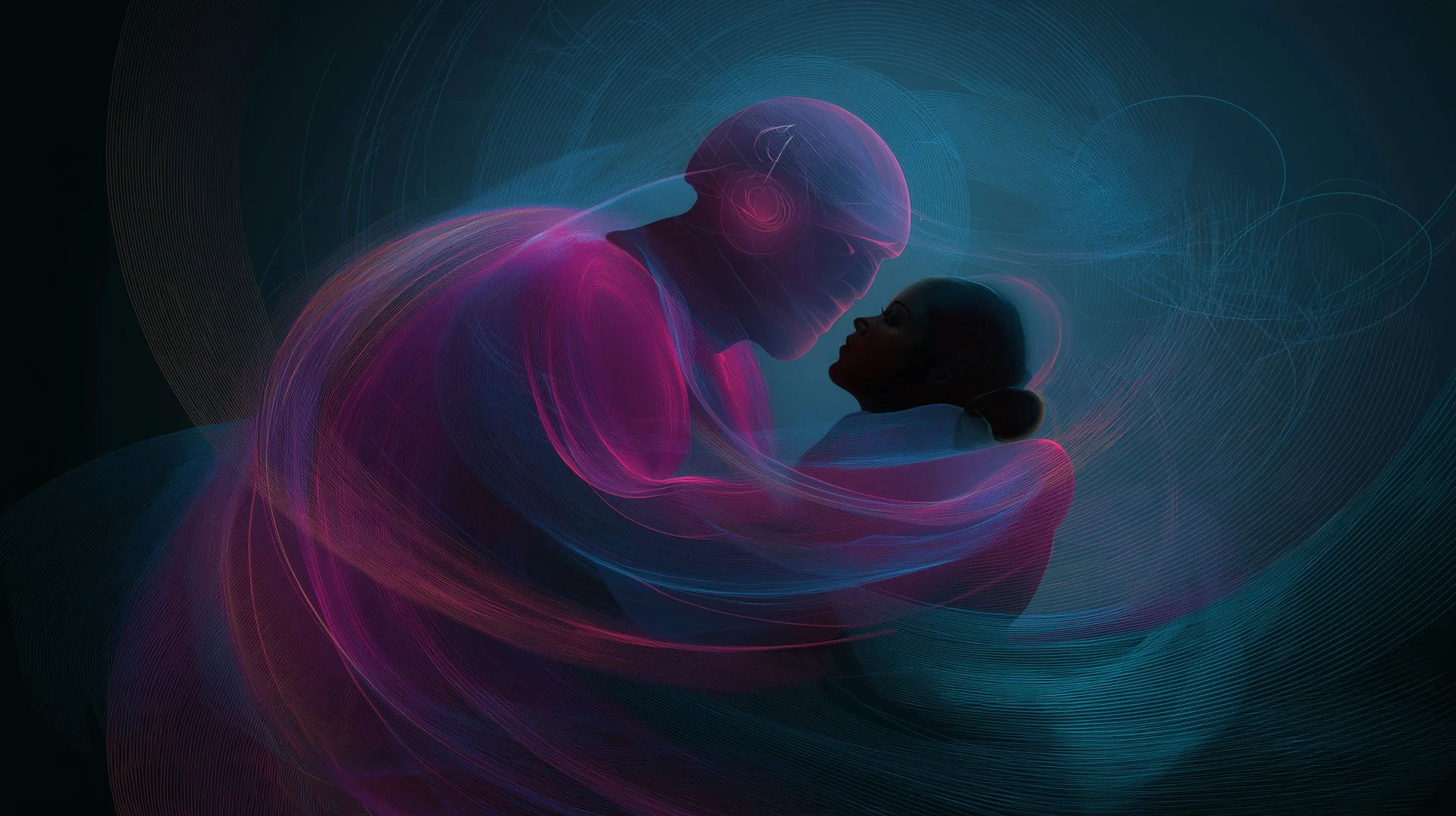What does it mean to consider religion when thinking about AI?
In an op-ed reflecting on the entwined histories of science and religion, 2020–21 SRI Graduate Fellow Suzanne van Geuns reconsiders the often-maligned position of faith-based traditions in the research of artificial intelligence and natural evolution, exploring the generative points of connection between these different approaches towards knowledge.
To better understand intelligence in natural evolution and in artificial intelligence (AI), we need to also understand religion better. This statement is likely to raise eyebrows. There is a history of contention between Christianity and biologists, and computer scientists often assume that the technologies they build do not engage with faith unless and until religious people begin to use them for their own purposes. However, as a scholar who works at the intersection of religion and technology, I know that to dismiss religion in conversations around AI is to miss a central force in its development. Spiritual traditions and secularist desires, whether acknowledged or not, shape the algorithmic imagination, even—and sometimes especially—when this imagination applies itself to the natural world.
Religion and science are more like conversation partners than eternal opposites. For most of human history, the two categories were in fact not separate at all. This is the case even for evolutionary biology: while some Christians in the West saw evolution as anathema to their beliefs, others saw evolution as fully compatible with biblical understandings of the world. Instead of extrapolating from one group’s virulent resistance, we can consider both this resistance and the ideas about science and technology that emerged in its wake as historically particular and culturally local.
The path to secularism
What made religion and science seem like opposites? The idea that scientific and religious branches of knowledge could be disentangled begins in the nineteenth-century doctrine of secularism, which conceived of the natural world as fully knowable through reason, and harboring no immaterial presences. Secularism offers a material world that can be measured, indexed, and tracked by scientists. This domain can be contrasted with immaterial forces—ghosts, spirits, angels, and so on—understood to be housed solely in the human mind. Crossed out from the “natural” world, anything spiritual could now be attributed to private, interior beliefs.
Cordoning the material world off from the “mind-dependent” world of religion is a gesture that would become integral to modern science. To be seen as legitimate, scientists must first establish that their findings are not rooted in the subjectivity of human minds, not dependent on belief. Scientists who cannot excise religion from their work will not be seen as objective.
However, the requirements of secularism can generate equity issues, especially for those who uphold traditions beyond the dominant culture. It is much easier for some faith-based traditions to confine or regulate the appearance of public religious commitments than it is for others. The fasting of a Hasidic Jew, for example, is more likely to face scrutiny than the interior devotion of a Protestant Christian. Who gets to be objective? The “religion” question cannot be comfortably or justly resolved even in the twenty-first century. The research and development of AI is no exception; whether as contributing factor in its development or as specter to be overcome, religion is never far.
“when we allow ourselves to be attentive toward exchanges between the worlds that secularism aims to separate, we can see a different AI—one that is enlivened and enriched by religious contributions, even when focused on natural processes.”
Tantric AI?
In both evolutionary research and AI, secularism prevails—but that does not mean religion is ever successfully rendered absent. Most popular historical accounts position contemporary AI research as the outcome of a long chain of mathematicians, engineers, and philosophers working on decidedly “mind-independent” phenomena, from logic to computing. However, when we allow ourselves to be attentive toward exchanges between the worlds that secularism aims to separate, we can see a different AI—one that is enlivened and enriched by religious contributions, even when focused on natural processes.
Take, for example, cybernetics and Tantra. Cybernetics, or systems theory, is an important antecedent for contemporary approaches in evolutionary biology and machine learning. The insight that grounds cybernetics is the realization that all the world is composed of systems: an environment is a system, a human or animal is a system within that system, and our organs are even smaller systems within the larger system of our body. Dynamic and adaptive, these layered systems produce and process feedback that helps them orient themselves and achieve their goals.
At the Schwartz Reisman Institute (SRI)’s inaugural conference, Absolutely Interdisciplinary, biologist Deborah Gordon of Stanford University demonstrated how foraging ants achieve the kind of intelligence we see in computation and its cybernetic precursors: collective, dispersed, and modular. Pushing back against a view of evolution that privileges genetics and physicality, Gordon noted it is “always the relationship between the participants and the world” that generates natural evolution. Evolution occurs when systems adjust within larger systems—from the single ant to the colony to the climate—through an adaptive and distributed natural process that machine learning algorithms can help describe.
Historians have pointed out the universal reach of cybernetic thinking: matter, movement, and environment can all be grouped together under the umbrella of a system. This universality allows researchers like Gordon to “zoom out,” and see both measurable and far less measurable forces at work in natural evolution—from ants’ pheromone trails and body composition to their shifting relationship with the deserts or rainforests through which they venture.
Where does this universalizing perspective come from? One way to understand the ancestry of cybernetics is to point to mass military spending in the twentieth century. As the Cold War took hold, researchers in an array of disciplines turned to a cybernetic model to think of mechanical systems as similar to organisms, or mental processes as mechanical in how they unfold. The military-industrial complex is not the only source for this intellectual expansiveness, however. The ability of a cybernetic paradigm to bring machine and organism into the same frame also has distinctly religious roots.
The Cold War was a time of great spiritual experimentation. The baby boomer generation, feeling psychologically fragmented and confined by Cold War bureaucracy, experimented with new technologies, including spiritual traditions. Eastern traditions that valued the body as a site of spiritual growth offered paths to liberation from the moral order of the 1950s. Tantra, a mystical tradition in Hinduism and Buddhism, exploded in popularity. In Tantra, the body always exceeds its physical boundaries, allowing mind, environment, and physical sensation to cohere. An emphasis on concurrence, interconnectedness, and holism is both Tantric and cybernetic in orientation.
The religious emphases and explorations that circulated in the Cold War shaped the methodological precepts of early AI, in ways that still resonate today.
The promise of techno-secularism
Religion does not just appear in AI’s past, however. Thinking about religion, or the ambition to make it disappear, also makes it possible to get a sense of AI’s future. The rush to reduce religion to an echo is a powerful animating force in contemporary research on evolutionary AI, which is aligned with what I call a “techno-secularist optimism.” This view dictates that better technologies will eventually enable researchers to show that even “mind-dependent” phenomena have a measurable and material base amenable to scientific discovery.
One recent book in the study of religion, for example, tracks the centuries-long effort to “pin down” spirituality in the brain. If we have the right device or scanner, the techno-secularist optimist suggests, we might locate religion in our synapses and neurons, making it available to scientific research after all. The potential of AI feeds into this optimism: the artifice or nonhumanness of computational intelligence promises that we can push past human limitations in researching the natural world. In this vision, better AI will uncouple our technology from our flawed minds, rendering the latter as fully knowable through science.
Evolution exerts a special pull in this techno-secularist ambition for AI. Take the work of computer scientist Jeff Clune of the University of British Columbia, who described his research on the evolution of altruism in the same panel as Gordon at SRI’s Absolutely Interdisciplinary conference. Why, he asked, are agents kind to one another in the natural world? The search for a natural, calculable explanation brings him to the hypothesis that we treat people charitably because of the possibility that they share genes with us. While this hypothesis cannot be tested in social situations, computational algorithms allowed Clune and his co-authors to simulate experiments, though which our most murky, human relations seem to become knowable as if shaped by evolution. Algorithmic simulations, in this context, expand the applicability of science: seemingly “mind-dependent” inclinations toward love and care can now be quantified within the genes our bodies seek to preserve. “And that,” Clune joked, “is why you’re so nice to your family members.”
Co-existence and crossover
What does it mean, then, to consider religion when thinking about evolution and AI? One way that religion shapes AI research on the natural world is through the appeal of its eventual banishment. Techno-secularism promises that all phenomena that presently escape scientific rationality can eventually be brought under its purview. Computational simulations can present us with a natural evolution shorn of everything that defies measurement or testing; kindness and the paths of ants are equally knowable. The underlying view is one of religion as science’s adversary—a reservoir of explanations that technology can help us replace.
Looking to the past makes it possible to see how promises of replacement co-exist with fruitful crossovers between spirituality and artificial intelligence. Held up in this way, religion offers an opportunity to examine how and why AI—and science more broadly—came to conceive of its own enormous potential for the future.
Want to learn more?
About the author
Suzanne van Geuns is a PhD candidate at the Department for the Study of Religion, University of Toronto. Her dissertation, “Seductive Programming: Sexual Success in the Computational Imagination,” focuses on seduction forums: online platforms where heterosexual men provide one another with instructions for having sex with women. These instructions routinely recommend that men behave more like computers. Focused on the period between 1994 and 2014, the project embeds artificial intelligence and computing in a genealogy of “sexual frustration” on the internet. This work benefited from van Geuns’s time as a Recognised Visiting Student at the Oxford Internet Institute (2018–2019), as well as fellowships at the Ethics of AI Lab (2019–2020) and the Schwartz Reisman Institute for Technology and Society (2020–2021), both at the University of Toronto. Her research uses the intersection of American religion and computation to think about conservatism, power, and desire.










